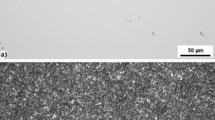Abstract
We present a procedure for measuring the dynamic fracture-initiation toughness of materials. The method is based on three-point bending tests at high loading rates, performed in an experimental device which is a modification of the classical split Hopkinson pressure bar. Coupled with the loading device, a high-speed photography system was used to measure the crack mouth opening displacement (CMOD) directly on the specimen. The stress intensity factor was calculated by three different simplified methods and the time to fracture was obtained from an appropriate specimen instrumentation. To evaluate the results derived from the simplified methods, a two-dimensional full-numerical analysis of the dynamic bending fracture test was made. The model includes the specimen, the input bar, the impacting projectile and the supporting device and takes into account the possible loss of contact during the experiment between the input bar and the specimen and between the specimen and its supports. From the tests and numerical results, it can be concluded that the CMOD procedure, together with the knowledge of the time to fracture determined using crack gages, seems to be the best method for measuring dynamic fracture-initiation toughness.
Similar content being viewed by others
References
Ruiz, C. andMines, R., “The Hopkinson Pressure Bar: An Alternative to the Instrumented Pendulum for Charpy Test,”Int. J. Fracture,29 (2),101–109 (1985).
Yokoyama, T., “Determination of Dynamic Fracture-initiation Toughness Using a Novel Impact Bend Test Procedure,”J. Pressure Vessel Technol.,115 (2),389–397 (1993).
Bacon, C., Färm, J., andLataillade, J., “Dynamic Fracture Toughness Determined from Load-point Displacement,” EXPERIMENTAL MECHANICS,20 (1),217–223 (1994).
Beinert, J. andKalthoff, J., “Experimental Determination of Dynamic Stress Intensity Factors by Shadow Patterns,”in Mechanics of Fracture, G. Sih (ed),Vol. 7, Martinus Nijhoff, The Hague, 281–330 (1981).
Ravi-Chandar, K. andKnauss, W., “An Experimental Investigation Into Dynamic Fracture: I. Crack Initiation and Arrest,”Int. J. Fracture,25,247–262 (1984).
Benitez, F. andAndrade, L., “In-plane Impact Loading of Composites: Optical Evaluation and Crack Severity Assessment for Graphite-Epoxy,”J. Physique IV,7,C3-169–C3-176 (1997).
Dally, J. andBarker, D., “Dynamic Measurements of Initiation Toughness at High Loading Rates,” EXPERIMENTAL MECHANICS,28 (3),298–303 (1988).
Kishimoto, K., Aoki, S., andSakata, M., “Simple Formula for Dynamic Stress Intensity Factor of Pre-cracked Charpy Specimen,”Eng. Fracture Mech.,13 (3),501–508 (1980).
Kishimoto, K., Kuroda, K., Aoki, S., andSakata, M., “Simple Formulae for Dynamic Fracture Mechanics Parameters of Elastic and Viscoelastic Three-point Bend Specimens Based on Timoshenko's Beam Theory,”Proc. 6th Int. Conf. on Fracture, New Delhi, India, S. Valluri et al. (eds),Vol. 5, Pergamon, Oxford, 3177–3184 (1984).
Nishioka, T. andAtluri, S., “A Method for Determining Dynamic Stress Intensity Factors from COD Measurement at the Notch Mouth in Dynamic Tear Testing,”Eng. Fracture Mech.,16 (3),333–339 (1982).
Popelar, C., Anderson Jr, C., andNagy, A., “An Experimental Method for Determining Dynamic Fracture Toughness,” EXPERIMENTAL MECHANICS,40 (4),401–407 (2000).
Nishioka, T., Perl, M., andAtluri, S., “An Analysis of Dynamic Fracture in an Impact Test Specimen,”J. Pressure Vessel Technol.,105,124–131 (1983).
Crouch, B., “Finite Element Modeling of the Three-point Bend Impact Test,”Comput. Struct.,48 (4),167–173 (1993).
American Society for Testing and Materials, ASTM E399-93 Standard Test Method for Plane Strain Fracture Toughness of Metallic Materials, Annual Book of ASTM Standards, Vol. 03.01, Philadelphia, PA (1983).
Tada, H., Paris, P., andIrwin, G., “The Stress Analysis of Cracks Handbook,”2nd edition, Paris Productions, Inc., St Louis (1985).
Rubio, L., Fernández-Sáez, J., andNavarro, C., “Factor de Intensidad de Tensiones Dinámico en Probetas de Flexión en Tres Puntos y de Flexión en un Punto Sometidas a Pulsos de Carga de Corta Duración,”Anales de Mecánica de la Fractura,15,97–101 (1998).
Guinea, G., Pastor, J., Planas, J., andElices, M., “Stress Intensity Factor Compliance and CMOD for a General Three-point Bend Beam,”Int. J. Fracture,89 (3),103–116 (1998).
ABAQUS User's Manual Version 5.8, Hibbitt, Karlsson & Sorensen, Inc. (1997).
Nishioka, T. andAtluri, S., “Path Independent Integrals, Energy Release Rates, and General Solutions of Near-tip Fields in Mixed-mode Dynamic Fracture Mechanics,”Eng. Fracture Mech.,18,1–22 (1983).
Nishioka, T., “On the Dynamic J Integral in Dynamic Fracture Mechnics,”in G. P. Cherepanov (ed), “FRACTURE: A Topical Encyclopedia of Current Knowledge, Dedicated to Alan Arnold Griffith,”Krieger Publishing, Malabar, FL, USA, 575–617 (1998).
Author information
Authors and Affiliations
Rights and permissions
About this article
Cite this article
Rubio, L., Fernández-Sáez, J. & Navarro, C. Determination of dynamic fracture-initiation toughness using three-point bending tests in a modified Hopkinson pressure bar. Experimental Mechanics 43, 379–386 (2003). https://doi.org/10.1007/BF02411342
Received:
Revised:
Issue Date:
DOI: https://doi.org/10.1007/BF02411342




